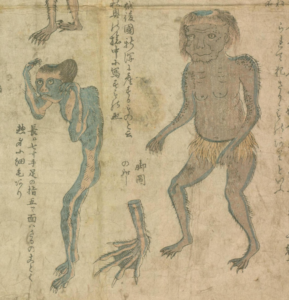projects
The Evolution of Kappa, or: Science and Environmental Change in the History of a Fictive Species in Japan

To be presented at the conference, Biodiversity at a Crossroads: Interdisciplinary Perspectives on Biodiversity Change across Asia, Past and Present, National University of Singapore, July 13–14, 2023.
Japan’s “modern” revolution instigated a reconfiguration of environmental knowledge, agrarian practice, and spiritual meaning. It also restructured landscapes according to new, scientifically underpinned rationalities. This contribution studies the history and evolution of a fictive species across this transition. “Kappa” is an eerie animal that has long puzzled farmers and intellectuals in Japan with its manifold appearances. Revealing itself in various forms – beaked, armored, or utterly anthropomorphic – the otter-like creature wove its way across the boundaries of academic knowledge and folk belief. Kappa were said to feed on cucumber and the human liver, and to fear monkeys and iron items. Though they were known to belong to the realm of yōkai ghosts, the efforts of early modern botanists to catalogue the environment also construed Kappa as a creature of the physical world. Influential encyclopedias such as Terashima Ryōan’s Wakan Sansai Zue or the authoritative Honzō Kōmoku Keimō connected the mythical figure to empirically confirmed creatures, and defined up to twelve different races or subspecies. Similarly to mummified “mermaids” traded as medical product in early modern Europe, dried otter paws were exhibited as “Kappa hands” in a spiritual or sensationalist contexts in Japan.
As globalizing scientific discourses incorporated agrarian landscapes more systematically into the project of national power in the late nineteenth century, industrialization gradually altered the symbioses of the agrarian wetlands. In the process, formerly important presences – both mythical and biological – were marginalized, vilified or systematically eradicated. With the “modern” restructuring of knowledge, Kappa were removed from biological discourses and banished to the realm of popular fiction. Conversely, the Japanese Otter, a now-extinct species that lived at the rims of the cultivated land, was extrapolated from its popular association with Kappa. Once profaned, otters were commodified for their liver’s healing powers, derived from kappa myths. The rapidity of the otter’s population collapse in the first years of the twentieth century due to overhunting and habitat destruction, on the other hand, inspired attempts at preservation early on. Efforts to rescue the otter from industrial destruction continued throughout the postwar period. Five decades since the last sighting of a live otter in Japan, the animal today remains a mascot for local environmental protection, and a representative of the toll of modernization.
The “evolution” of kappa and otters as seen in scholarly and popular discourses since the seventeenth century is a mirror of changing human-environmental relations in the longue durée. It reflects how species and subspecies were constructed based on historically changing empiricisms, and it illustrates how the afterlives of a species exposed as fictive continued to guide the fetishization of associated animals to the point of extinction. Connecting early modern scholarship to the emergence of a conservationist conscious in the twentieth century, this project explores the modern history of Japanese environmental science as embedded in popular knowledge and changing symbioses in the agrarian realm.
